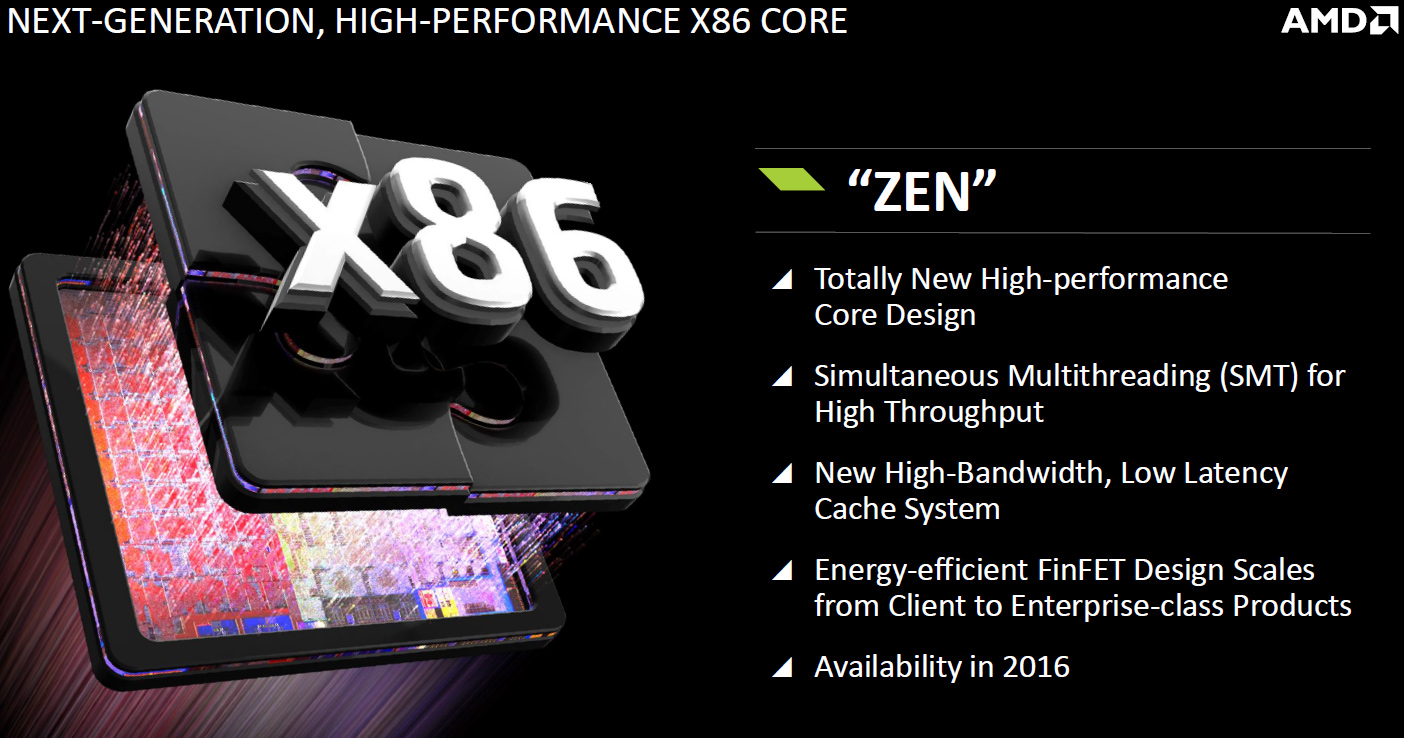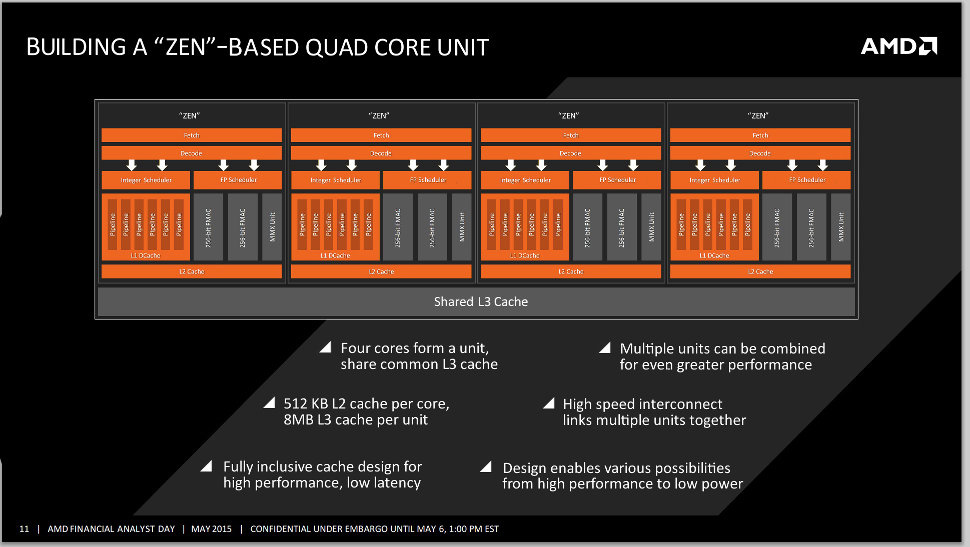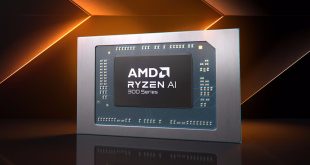Advanced Micro Devices has not updated its server and high-end desktop microprocessors for well over two years now, which is why market shares of AMD Opteron and AMD FX central processing units are negligible. However, a lot may change next year, when AMD roll-out its next-generation CPUs based on its code-named “Zen” microarchitecture, according to a financial analyst.
“We believe that AMD has a strong design team working on the new ‘Zen’ processor core due out next year,” wrote Gus Richard, an analyst with Northland Capital Markets, in a note to clients, reports Tech Trader Daily. “We believe that this will be a significant improvement over its current product offering, and may enable AMD to once again be a viable second source to Intel in the data center. “
AMD has not revealed a lot of information about “Zen” yet, but what is known is that the company’s upcoming high-performance x86 processor cores offer 40 per cent higher instructions per clock performance compared to “Excavator” x86 cores. This means that AMD’s next-gen central processing units will be 40 per cent faster compared to existing CPUs at the same clock-rate.

According to unofficial information, desktop microprocessors based on “Zen” micro-architecture will integrate up to eight cores, whereas server-class chips will feature even more cores. The CPUs are expected to be made using 14nm FinFET process technology at GlobalFoundries.
Since the new AMD Opteron and FX processors are going to hit the market only in the second half of 2016, they will have a significant impact on the company’s revenue and earnings only in 2017. However, Mr. Richard believes that the popularity of AMD’s new server chips will grow rather rapidly because operators of datacenters are willing to invest in hardware that competes against Intel, which is dominating the market.
“We hear that web scale data center operators are frustrated with Intel’s control of server architecture and high prices,” said Mr. Richard.

The analyst estimates that sales of AMD Opteron processors based on “Zen” architecture could hit around $1 billion in 2017. Last quarter AMD earned $1.03 billion in total, so addition of “Zen” is projected to be dramatically important for the company.
“We estimate that with roughly 10% market share or $1 billion in datacentre revenue, gross margin in calendar year 2017 would increase to the high 30% range and earnings per share could reach roughly $0.50,” said the analyst. “This would be in line with AMD’s three to five year target model.”
Discuss on our Facebook page, HERE.
KitGuru Says: AMD has tremendous troubles with its microprocessors, accelerated processing units and some other products today. If the company executes its “Zen”-related plans well, it may become rather successful. However, one of the problems is that it not enough to offer just one award winning processor. AMD needs to introduce a competitive lineup and then follow-up with equally competitive family a year later. Will AMD be able to do it? Only time will tell!
 KitGuru KitGuru.net – Tech News | Hardware News | Hardware Reviews | IOS | Mobile | Gaming | Graphics Cards
KitGuru KitGuru.net – Tech News | Hardware News | Hardware Reviews | IOS | Mobile | Gaming | Graphics Cards



I saw the webcast of analyst presentation on may 6th live and there was NO indication of WHEN the zen parts will be introduced. For all we know, the desktop part may ship in the first quarter of 2016. This article arbitrarily assumes they will ship in 2nd half of 2016 and revenues will accrue in 2017 so they will not get paid for the shipments in 2nd half of 2016 ?
Zen is too weak, to make serious money for AMD. Intel’s IPC is nearly 100% higher than current Bulldozers, so improving by 40% wont be very helpfull. Zen v1 can’t be improved anymore. For now design is frozen, and go through several respins, to achieve desired speed, power consumption and yield.
hey what if Zen is just 40% higher ipc but the clock is also 50% higher? or maybe the architecture is different the piledrivers once clocked to 5 ghz arn’t that far behind intel in raw performance also remember that piledriver is built on 32 nm and intel is on 22 nm just an nm chance can change performance dont count amd out just yet i recently changed to intel because they taking ages sure it plays games a little smoother but its also got pcie 3.0 and can take high clocked ram but what i noticed is its about the same time in video editing and stuff and more chance of freezing up or games crashing so whatever there both good amd hasnt released a high end chip in 3 years and there still up there almost with the 4000 intel’s
That 40% IPC improvement AMD saying is over Excavator. We don’t know how a full fledged Excavator FX CPU (not carrizo APU) would perform.
May be they are talking about the actual profit which may only start from 2017 onwards.
based on random speculation ? Well, ‘they’ can be talking anything out of anywhere then, can’t they ?
I remember an analyst asking a pointed Q at the presentation as to the date of zen introduction and suggesting something similar to what is mentioned here but Papermaster quickly jumped on that speculation and pointed out that zen’s introduction date has not been mentioned anywhere. One can conclude anything from that- and even that they are having ‘technical difficulties’ and so its launch is delayed.
Unfortunately, I have seen a lot of misinformation and rumours directed against AMD, and I am free to speculate that that is due to concerted effort by its detractors/competitors to undermine AMD’s market position. Without warrants, I cannot follow the money trail and prove it but even if I proved it, so WHAT ? Corporations do all kinds of unethical things and get away with it while the government at best looks askance at them.
Yesterday, there was this rumour (denied by AMD today) everywhere that Fiji will have limited production. A week ago, there was misinformation about GCN based radeons not supporting directX 12. And so on.
is there any sense in the sentence, “Intel’s IPC is nearly 100% higher than current Bulldozers” ?
First of all, what is a current bulldozer ?
What is an intel IPC ? Do you mean a specific part ? A particular die ? Which one ?
Where are the numbers for comparison ? What are the sources ? Do you KNOW what you are saying ?
These are the kinds of lies that intel’s minions (probably paid trolls) have been spreading on the internet- no name nobodies writing nonsense on the internet and people lapping it up without having any means of verification – most people do not even know HOW to do that and that includes many tech authors.
your not taking into account the benefit of the node shift to 14nm – that will bring significant performance aswell…while i dont think they will surpass intel I do think they may get closer than we think
AMD’s APU’s are superb for what they are and most people just dont need so much IPC. they really appreciate the proper iGPU power which intel will never match.
Zen APU’s are what we should be waiting for although I have heard good things about the new 28nm bristol ridge APU’s which support DDR4 to help allievate the GPU bottleneck so it can stretch its legs abit
Hate to burst your outdated bubble, but Intel is on 14nm atm, and will be shifting to 10nm in 2016
Ever since the original Phenom launch, all of AMD’s CPU’s have been the “paper tiger” launches, and have fallen well below their expectations performance wise against Intel. Who knows, maybe they will perform as advertised or better, but knowing AMD track record ever since C2D launched 9 years ago, its best to wait and see real world results, instead of all this paper talk.
Seriously… You know what he’s talking about instructions per cycle for the AMD FX series is half that of Intel’s desktop 4XXX CPU’s.
And no I don’t need to specify a particular CPU because all the FX line and Intel’s 4XXX series desktop CPU’s respectively have the same cores just at different clock rates / core counts. And no I don’t mean that AMD and Intel are using the same cores I’m saying the FX line all uses the same core and the desktop 4XXX series all uses the same core.
And IPC is instructions per cycle per core so its not based on clock rate or core count which are the only distinguishing factors between CPU’s in either the FX line or the Intel 4XXX line, and yes the FX line does have double the cores of the 4XXX line but that doesn’t help the massive amount of applications which do not utilize more than 4 cores.
Even DX12 will not fully utilize 8 cores it only scales well upto 4 cores with 100% utilization of Core0 and around 70% utilization of core 1 – 3. after that its starts getting messy with negligible improvements this is a graph of how DX12 scales with 8 cores
http://www.techpowerup.com/img/15-03-23/100h.jpg
And here is with 4 cores
http://cdn2.wccftech.com/wp-content/uploads/2014/12/image_3.png
So yeah the extra cores are not really helping you there because as you can see adding more cores actually decreases the utilization of core 3 and 4 so it ends up that you only get an extra 20% performance.
So yeah 40% IPC improvement is kinda not great, and really Intel has no reason to mess with AMD at this point because dominating them and if they were to do it any harder AMD would go out of business and they would have to deal with anti trust laws and law suits.
Everything since Phenom was a means to catch up to Intel it was impossible to catch up in a few releases
the entire construction set from Bulldozer to Excavator was a step by step process in that endeavor.
people don’t understand that chip producers don’t have make 3 chips so that they can improve 20% at a time, they can just skip the first 2 and make the 3rd one that is 60% better. Both AMD and Nvidia have designed their architectures for 5 years ahead, you can see it in the roadmaps that they show, but why would you release the best you have when you can stall with weaker ones for a long time as intel is doing.
Also Zen should have at least Sandy Bridge IPC.
Keep in mind that bulldozer/piledriver/steamroller cores were twice as small(size/nm) compared to intel’s haswell/ivy bridge/sandy bridge so 2 amd cores do beat 1 intel core and they are at the same size, keep that inmind.
I appreciate your enthusiasm for APU, but higher IPC is important as well in games. The new Broadwell i5 and i7 with Iris Pro 6200 out-beaten A10-7850k by a lot (that’s most probably because of it’s higher CPU IPC, compared to the A10 and probably with the eDRAM in Broadwell which helped the iGPU too, by little margins). You can see some comparisons at Tom’s Hardware (searching for Broadwell: Iris Pro Graphics 6200 Gaming Results), where in Bioshock Infinite, Intel scored 80 FPS, while A10 7850k with 2400MHz RAM scored 60. Not to mentioning that Intel did it using less power.
It’s frustrating, but I hope Godavari 8850K will even the match a little. The new Zen APU, if it really comes with HBM 2.0, like the rumors says, will actually make the top-end APU iGPU compare with mid-range GPU. Even if we might not yet see HBM in APU (like Intel does eDRAM in their CPU), the DDR4 RAM will help the Zen APU anyway, offering higher bandwidth, not to mention the 40% improved IPC over the Excavator cores.
Enthusiast will aim for AMD 8/16 core CPU with some serious GPU (Fury X anyone?), but I prefer very compact build, to cram as much compute power in as little space as possible and that’s where something like Zen APU might come handy (Intel might have already won some compact size casual gaming rigs and HTPC).
i think with amd’s APU having an advantage in graphics performance, and the gaming shift towards x86 architecture, as well as all games using only a few graphics engines which utilize multicore processors. Laptops in the APU segment, $300-$800 are now capable of playing modern games. So kids will be asking for amd laptops so they can play and do their schoolwork. Theyll take a significant marketshare in the lower tier laptop range.
the only scenarios were intel would be 100% faster then AMD in per thread score would be a nearly 100% FPU (floating point) workloads, which is a weak point of AMD’s bulldozer (they were designed with the idea that the GPU would take over those tasks, but the software just isn’t there yet)
Zen however will be getting 4 times the per core FPU bandwidth compared to bulldozer. its FPU is going to be twice as wide and won’t be shared between 2 cores.
in heavy FPU workloads the IPC increase will be substantially more then 40%
Shifting to 10nm isnt as easy as you might think. Production for this design will be slow and they are already struggling to produce i7-6700k’s on the 14nm process due to them not meeting certain specifications. They have already lowered the advertised turbo boost in order to get more of the chips out there.